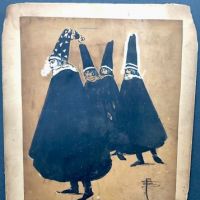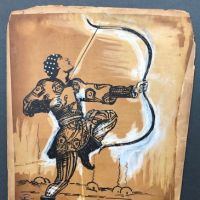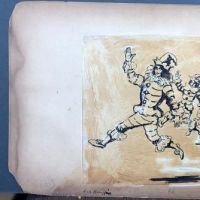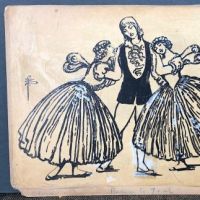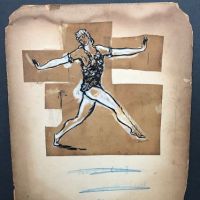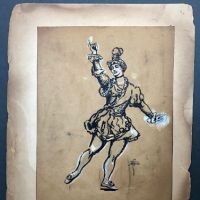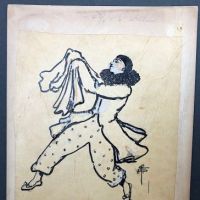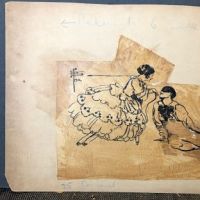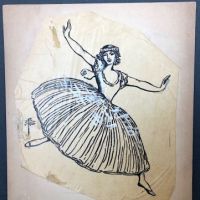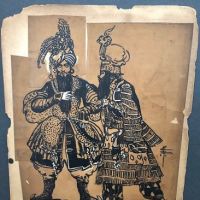Pamela Colman Smith Original Drawings for 1913 Russian Ballet Book by Ellen Terry and Pamela Colman Smith
O
More Detailed images and description for each piece will be documented and coming soon.
Pamela Colman Smith (1878-1951). If you’re a follower of the Tarot, you may recognize her name but surely know her art. A British born artist, writer, occultist, and activist, Smith is best known for illustrating the famous Rider-Waite-Smith tarot card deck, published in 1909. But before and beyond that effort, Smith produced a lifetime of unparalleled and enigmatic work, including whimsical books and illustrations, Jamaican folklore, literary magazines, and even a small press she founded to support women writers. While Smith nearly always struggled to make a living in art, her enterprising spirit cast her out among the greatest cultural ringleaders of her time, including Alfred Stieglitz, William Butler Yeats, and Bram Stoker.
Sturgis Antiques is pleased to have obtained a handful of original illustrations done by Smith in 1913 for the book, The Russian Ballet by Ellen Terry. These are truly rare, as only 13 of all 27 were thought to have survived until now. I came across them while evaluating the collection of a client whose family sold, commissioned and framed art in New York and Baltimore during the mid-nineteenth century. They were in a box and mounted to board with the original printer notes still attached. Upon finding these pieces, my reaction moved from disbelief to awe in a matter of seconds. Something like, “This is not real,” to, “Oh my God these are real!” and finally, “How did your family end up with these?” While my client does not know the exact answer, the work was most likely obtained through his family’s long standing connections with the art world.
But back to Smith, because she’s fascinating.
She was born in England and at age 11, moved with her family to Jamaica, where she was introduced to folklore, and immersed herself in illustration and costume design. At age 15, she moved to Brooklyn to attend Pratt Institute. Smith left early without a degree but continued to pursue illustration and gained a reputation for “fanciful” and “suggestive” work, including her depiction of Lady Macbeth in the 1899 edition of Shakespeare’s Heroines Calendar. What set her version apart was her giving action and words to a woman not a man in her depiction of Lady Macbeth.
At 21, Smith moved to London, and began working on costume and stage design for the Lyceum Theatre group, which was led by Henry Irving, Bram Stoker and Ellen Terry. She became known as Pixie—a nickname given to her by Terry—because of her small stature and impish smile. It was also in London where Smith established weekly gatherings at her home for well-known artists, writers and actors.
Over the next few years, Smith’s work was published in many high profile and respected magazines and journals in America and Europe. She illustrated several books on Jamaican folklore, English and Scottish ballads, and an entire alphabet of Shakespearean characters. “I never look up a costume, and yet I seem to know exactly what every character should wear,” she once said of her drawings.
In 1902, Smith self-published The Green Sheaf—a literary magazine with contributions by established authors. Eventually, the magazine evolved into a small press focused on women writers. Smith was a well-known supporter of the growing Suffragette movement and through her own experience, had become disillusioned with male publishers. In the years that followed, she was prolific in her own art and gained more widespread recognition after participating in an exhibition curated by Alfred Stieglitz in 1907. She’d also been introduced to the Hermetic Order of the Golden Dawn, where she met and later followed writer Arthur Edward Waite to the Holy Order of the Golden Dawn. Waite commissioned Smith to illustrate his tarot deck.
By 1910, Smith was involved in many book projects. This brings me to the collection of drawings she made for The Russian Ballet, which chronicles the rise of Ballet Russe from its founding in 1909 by Sergei Pavlovich Diaghilev. The Russian Ballet gave written attention to what was a new movement in ballet that focused on the “dramatic intensity of male dancers.” Smith’s accompanying illustrations captured the emotion behind these dancers, with special attention paid to Vaslav Nijinsky, who was considered to be the greatest male dancer of the early 20th century. The Russian Ballet was published by Sidgwick and Jackson in England and then by the Bobbs-Merrill Company in the United States, whose reputation had blossomed after they published The Wonderful Wizard of Oz by L. Frank Baum in 1900.
Just after the end of WWI, Smith received an inheritance from a distant family member and settled in Cornwall. She converted to Catholicism and became somewhat of a recluse. She turned inward and began making art much in the same way she did as a child—quietly and for her own entertainment.
Pamela Colman Smith’s life story is one of a woman who lit her own torch in an elite world of art and writing that was dominated by men. Despite this, she held steadfastly on to her own sense of whimsy and fantasy—in the beauty and strength she recognized and captured in all of her work.

